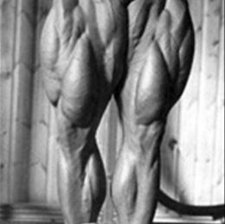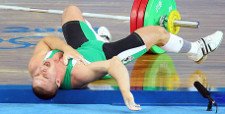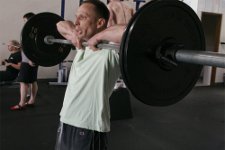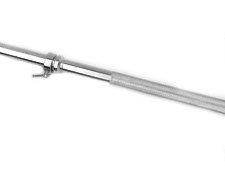The Deadlift: Minimum Effort, Maximum Results
 Deadlifts are an essential exercise when it comes to working out. They are foremost a lower-back exercise, but they work your entire backside from your glutes to your neck. The deadlift engages your entire core and all of the muscles in your legs. It also is an exercise with real-life application as the exercise mimics something many of us do all day long — bending over to pick things up!
Deadlifts are an essential exercise when it comes to working out. They are foremost a lower-back exercise, but they work your entire backside from your glutes to your neck. The deadlift engages your entire core and all of the muscles in your legs. It also is an exercise with real-life application as the exercise mimics something many of us do all day long — bending over to pick things up!
The high intensity of the deadlift will exhaust every muscle in your body. However, a deadlift can be dangerous if it is executed incorrectly. By following some simple rules, you can avoid injuries and achieve amazing results.
Upper and Lower Body Benefits
 When done properly, a deadlift works your upper and lower body simultaneously. It is considered one of the most effective ways to build strength in the legs, back, and core muscles. It is these large muscle groups that help to provide strength to the other smaller muscle groups in the body.
When done properly, a deadlift works your upper and lower body simultaneously. It is considered one of the most effective ways to build strength in the legs, back, and core muscles. It is these large muscle groups that help to provide strength to the other smaller muscle groups in the body.
The deadlift requires a minimal amount of equipment to perform, making it a great workout for both at home and at the gym. All you need is a weight bar or a set of free weights and you are ready to get started. Depending on the amount of weight you are lifting, you can also use wraps, and a weight belt is often suggested.
As I mentioned before, the deadlift helps to strengthen the core muscles in a person’s body, but that’s not all it does. It also works the hip flexors, the quadriceps, the hamstrings, calves, lower back erector muscles, abdominals, shoulders, and forearms. Because of the nature of the exercise, each of these muscles is completely engaged during the entire movement.
Injury Prevention
 As with any exercise, proper form is extremely important. Often people get injured when they are attempting to do a deadlift using a weight they aren’t ready to lift yet. Start at a lower weight or even an empty bar and get your form correct before you attempt move up.
As with any exercise, proper form is extremely important. Often people get injured when they are attempting to do a deadlift using a weight they aren’t ready to lift yet. Start at a lower weight or even an empty bar and get your form correct before you attempt move up.
Improper form puts the lower back at risk of injury during this exercise. You want the bulk of this exercise to be done with your legs rather than your back. It is also important to keep your abdominal muscles in tight and your back in a straight position. A rounded back puts you at a greater risk of injury to the lower back, including torn muscles, spinal disk injuries, and hernias.
If you have heart problems, a deadlift can also put a lot of pressure on the cardiovascular system. I would suggest checking with your physician before adding this move to your workout routine.
Another potential injury can be avoid by using the proper grip on your bar. It is recommended that you use either an overhand or and over/under-hand grip during a deadlift rather than an underhand grip. An underhand grip shortens the biceps muscle effectively increasing its load. This can lead to a possible torn muscle or tendons.
Deadlift Techniques and Variations
 By using the proper technique for deadlifts, you can prevent injury and increase your muscle mass. This technique will also help you to lift more weight.
By using the proper technique for deadlifts, you can prevent injury and increase your muscle mass. This technique will also help you to lift more weight.
Traditional Deadlift
- Stand with your feet shoulder-width apart and your weight bar on the floor in front of you. Bend forward and grab the bar with an overhand or an over/under hand grip keeping your abdominals in tight and your back straight. As you come forward press your tailbone to the back of the room and bend your knees slightly.
- Look straight ahead. Keep your back straight and flat, making sure not to round through the lower back.
-
Breathe in and lift by extending your legs and your waist. The bar (or weights) must remain close to your body as you exhale while you lift.
-
Keeping the bar close to your shins, slowly lower the bar back down, pause and repeat.
Sumo Deadlift – The Sumo Deadlift focuses more on your glutes and hips than the traditional deadlift. Stand with your feet as wide apart as you comfortably can with toes point out. Using a mixed grip (one hand over, one hand under), perform the deadlift as above.
Romanian Deadlift – The Romanian Deadlift starts in a standing position holding the bar, rather than beginning with the bar on the floor. With the Romanian Deadlift, the focus is on bringing your hips as far back as possible. Try imagining there is a wall two feet behind you that you are reaching for. Keep your abdominals in tight and your back flat as you return to your starting position.
Snatch-Grip Deadlift – This variation uses a wide grip, which forces you into a lower squat position engaging the quads even more. To determine the proper grip, stand with your arms out to the sides. The distance between your elbows is the same distance that should be between your hands with this grip.
Since the wider grip increases the distance the bar has to move, it also increases the difficulty of the exercise. You will want to start with a lower weight and work up to the weight you are using for your traditional deadlifts.
Additional Tips
 It is a good idea to practice the deadlift with a low weight or an empty bar before going higher weights. This will prevent you from sloppy movements that can cause injuries. This will also help you to train your muscles and get them prepared for the motion that you will be asking them to do.
It is a good idea to practice the deadlift with a low weight or an empty bar before going higher weights. This will prevent you from sloppy movements that can cause injuries. This will also help you to train your muscles and get them prepared for the motion that you will be asking them to do.
Straps are also suggested for the first few times with a new weight. The straps will help you to hold your grip with the new weight until your grip is strong enough to hold the bar.
The deadlift is a highly effective movement. However, it can also be very dangerous if it is not done appropriately. By following these tips and instructions, you can begin to use the deadlift and see big changes in your physique.
If you are not doing deadlifts in your current workout routine, they are a definite must. They will help you to reach your fitness goals, be they to firm your butt or bulk your hammies. Either way, you will be burning calories and building muscles.
